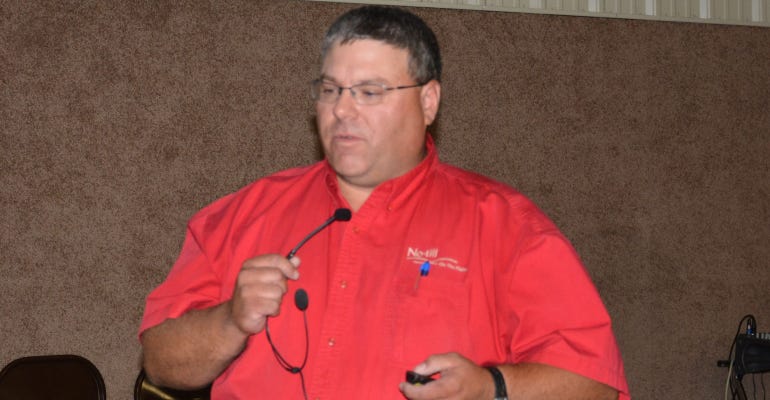
Diversity, intensity and rotations are the secrets to success at Jacob Farms in Sedgwick County near Bentley, according to co-owner Ryan Speer, who shared some of the secrets of regenerative agriculture success with more than 200 attendees at the summer Cheney Reservoir Watershed conservation group. The conference met in Yoder in mid-August.
Speer said the soils on the farm were down to about 1% organic matter when they started no-till and soil health conservation work 20 years ago. Tests now show they have made progress with organic content mow measuring about 3%.
“We started out looking at a 5-year rotation plan,” Speer said. “Now, we are evolving. We’re doing what the weather indicates and what the soil says it needs.
“I’m sorry seed salesmen, but I’m not buying seed in October anymore.”
He said he and co-owner Steve Jacob are adding diversity and intensity with both cover crops and cash crops. They are also working to match the crops that have the best synergies.
“Covers are a great way to mimic nature’s biodiversity. We have been able to reduce chemical fertilizer use and have reduced phosphorous on some fields to zero. Cover crops can help control pigweed, control nematodes, control fungal diseases and improve soil structure. We have seen a reduction in erosion from wind and water and an increase in beneficial insects,” Speer said. “We’ve learned that you either plant and grow what you want to grow or nature will take over and grow something. And it seems like nature’s something is usually pigweed.”
This year has been challenging indeed for Speer, who has seen repeated flooding that has stripped fields of years of no-till residue. He said there are some fields where they followed cover crops with cover crops because that was the only thing they could get in the ground.
 BEST PRACTICES: Ryan Speer, co-owner of Jacob Farms near Sedgwick, addresses attendees at a Cheney Watershed field day, sharing some of the practices that have helped make his operation into a model of regenerative agriculture.
BEST PRACTICES: Ryan Speer, co-owner of Jacob Farms near Sedgwick, addresses attendees at a Cheney Watershed field day, sharing some of the practices that have helped make his operation into a model of regenerative agriculture.

“What it comes down to is keeping the topsoil,” he said. “Soil loss equals profit loss. The best way to stop that loss is having living roots in the ground. When we first started talking cover crops in 2000, I was against it,” he said. “We did some side by side tests and we could see the difference. People ask me if it pays. I tell them it has to. Our farm supports three families.”
Records over a seven-year period show an average yield gain of 5 to 6 bushels using a variety of cover crops.
“That comes with reduced irrigation cost and reduced chemical costs which more than offsets the price of seed and planting,” he said.
Jacob Farms is also a Water Technology Farm, a partnership with Kansas State University and the Kansas Water Office to advance the use of technology with soil health measures to reduce water usage. Speer said they use low drip nozzles to get less evaporation and plant sensors to measure stress on the plant. It is one of 15 Water Technology Farms across the state.
He said he planted a circle of corn into grazed cover crop residue and used 40% less water to get the same yield as on he got from a no-till circle.
About the Author(s)
You May Also Like






